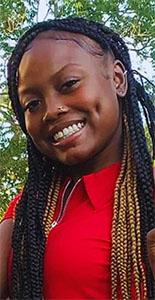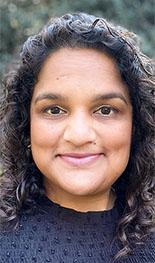A conversation for Pain Awareness Month and Sickle Cell Disease Awareness Month.

High school student with lived experience of sickle cell and chronic pain who receives care at the Aflac Cancer and Blood Disorders Center of Children's Healthcare of Atlanta
September is Pain Awareness Month and Sickle Cell Disease Awareness Month. We had the opportunity to speak with Endiya Sykes, Neshana Harper, and Soumitri Sil, PhD about their experiences related to sickle cell disease and chronic pain.
Endiya is a high school student who loves to read and dance. She lives with sickle cell disease and chronic pain. She gained experience with research as a past participant and as a current community advisory board member in a research study at the Aflac Cancer and Blood Disorders Center of Children’s Healthcare of Atlanta where she receives whole health care for sickle cell disease. Her mother, Neshana Harper, is actively involved in Endiya’s care and research participation.
They connected with Dr. Sil, Director of the Pediatric Psychology Clinic at the Aflac Cancer and Blood Disorders Center, through their work together on research projects. Currently, Endiya is a community advisory board member on the Integrative Strong Body and Mind Training (I-STRONG) for Sickle Cell Disease Study. This clinical trial tests how an intervention tailored for teens with sickle cell disease changes pain, mental health, and quality of life. The intervention uses mind-body, cognitive-behavioral, and neuromuscular treatment approaches. The grant is funded by the NIH Helping to End Addiction Long-term® Initiative.
What is it like to live with chronic pain?
Endiya explained that pain, “is not only a physical thing. It’s also a mental and emotional thing.” When she’s in pain, Endiya thinks about how bad the pain is, whether the pain will ever end, and how it sometimes feels unfair to live with daily pain. These thoughts affect her mood. She elaborated, “I get in a sad mood, or I get upset and I might take it out on everybody around me. I don’t like when that happens.”
What do you wish people knew about pain and sickle cell disease?
Both Endiya and Ms. Harper wish for less stigma around sickle cell disease and pain as well as fewer assumptions about what a person with sickle cell disease or pain should be like. “If you have pain, being active can help take your mind off the pain. But if you’re being active, it doesn’t mean you’re not still hurting, because the pain is still there,” Endiya explained. “When I try to be active to help my pain, sometimes people say, ‘you don’t look like you’re hurting.’ But then if I’m lying down hurting, then people might label that ‘weak,’ or ‘lazy,’ or that you can’t do anything that a normal person could do.”

Mother of Endiya Sykes who receives care at the Aflac Cancer and Blood Disorders Center of Children's Healthcare of Atlanta
Ms. Harper agreed, adding: “People look at her and say, ‘she doesn’t look like she has sickle cell’, but what is that supposed to look like?”
They both encouraged others to think about someone living with chronic pain as a normal person who is strong and going through life with the extra challenges that pain can bring.
Dr. Sil explained that it is important to approach people with chronic pain from a place of curiosity in trying to genuinely understand and learn from their experiences. This can better validate and support people living with pain without creating stigma, bias, or negative assumptions.
“Pain is different for everybody. A lot of times, pain can be invisible,” said Dr. Sil. “We have to remember that what we see is only part of the picture, and there’s so much more going on inside of a person. We have to be really careful about the assumptions that we make about what they might be going through.”
What has it been like to be involved in sickle cell and pain research?
About a year ago, Endiya participated in a research study that taught her skills to better help her manage and cope with her chronic pain. Endiya said she has seen improvements in her mood and coping strategies since that experience. “I like the fact that since I started [research] studies, I’ve actually seen different ways to cope with my pain. I’ve seen improvements in my mood, and I don’t take it out on other people. I’m happy all around because I’m finding ways to help myself, and I’m starting to better understand what’s going on with me.”
Her mother also described changes that she’s seen in Endiya’s well-being. “For me, the biggest thing was seeing a difference in her. She went from missing 12 days a year of school to 2-3 days, and that’s when we have to get her labs done. A lot of people aren’t open to trying research studies, so I am happy she has been, but she’s so driven. So, I know that once she sets her mind to something, she is going to do it.”
How has engaging people with lived experience of sickle cell disease and pain changed your research?

Associate Professor
Emory University School of Medicine, Director of Pediatric Psychology Center, Aflac Cancer and Blood Disorders Center of Children's Healthcare of Atlanta
The I-STRONG for Sickle Cell Disease Study uses a research approach called “community-engaged research.” This approach involves people with lived experience in the planning and design of the research project. Dr. Sil explained how this approach has improved her research. “As researchers, we lean on our community partners to help us understand what’s important and relevant to them. It helps us prioritize what questions and problems they are facing, to know what is meaningful, relevant, and important.”
She added that giving people with sickle cell disease and pain a seat at the table has helped her understand their potential unmet needs as well as outcomes that are clinically meaningful to them. She also explained that community-engaged research has helped her research align with the values, lived experience, and priorities of the teens and families affected by sickle cell disease and pain.
What advice do you have for people with lived experience of pain and/or sickle cell disease who want to become community research partners or research participants?
Joining a study as a community advisory board member or research participant is a new and very different kind of experience for people who have not been involved in research before. Endiya encouraged other teens who might want to get involved in research to take this step and noted, “You have to be willing to try new things. Even if it sounds hilarious or you think it’s not going to work, go ahead and try anyway. You might be surprised. I was surprised when most of the skills from the study worked for me.” Ms. Harper added that consistency and keeping a positive attitude also are factors that can benefit a research participant or community advisory board member.
From a researcher’s perspective, Dr. Sil encouraged people who are interested in becoming community advisory board members to be open and honest with the research team. “One of the things that I’ve appreciated about Endiya and Ms. Harper’s partnership is that they are very candid and honest in what works and what doesn’t. That kind of open communication and transparency is such an important piece of this that we may take for granted sometimes.” Although it might be intimidating to partner with researchers, Dr. Sil emphasized that, “Your voice is valuable, and it can make a difference.”
What advice do you have for researchers who want to start engaging people with lived experience of pain and/or sickle cell disease in the planning and design of their study?
For researchers who have not done community-engaged research before, it might be difficult to know where to start. Endiya, Ms. Harper, and Dr. Sil provided their advice on where to start, which interpersonal skills would be most important to develop, and how to connect with community members.
Where to start: Dr. Sil encouraged, “It’s ok to start with small steps. Engaging community partners in research exists along a continuum. It can feel overwhelming to do it in its most involved form.” She shared examples of small steps, like (1) speaking with one or two past research participants about what their experience in the study was like, (2) asking them how and where you can best share findings from that study with the people who participated, and (3) asking them for their thoughts on your planned next steps. She also noted that there is a rich literature base with suggestions that can help guide people who are new to this area and noted the importance of collaborators with expertise in community-engaged research.
Interpersonal skills: Endiya, Ms. Harper, and Dr. Sil all emphasized that trust, communication, and openness are key qualities that researchers should have when engaging people with lived experience of pain and/or sickle cell disease in their research.
Ms. Harper expressed, “I think it’s all about communication and your approach.” She added that she appreciates that Dr. Sil quickly replies to questions and makes them feel genuinely cared about as people, not just for the research. Endiya elaborated, “Dealing with someone with pain or sickle cell, it’s important to be understanding and willing to hear them out. Some of the things that we go through…it’s crazy. When we feel heard and understood, we’re more open to doing things.”
Dr. Sil explained that building trust with community advisory board members takes time and intentionality. “It’s more than a checkbox that needs to be ticked off. We need to be mindful about how we approach it, so we can avoid tokenism. You may not start off with high levels of trust and engagement because those relationships take time to be developed. But you can start by asking their opinions in a way that shows cultural humility, listening, and being respectful.”
Cultural humility is a person’s lifelong commitment to self-reflection that helps them learn about and respect another’s cultural values by recognizing how they align with or differ from their own. It helps people recognize where there might be power imbalances in a relationship to address and foster equity. Cultural humility goes beyond cultural competency. Instead of aiming to learn everything possible about someone else’s background, a person with cultural humility recognizes that there are parts of another person’s culture and experience that they will never understand. Instead, they value the other person as an expert who can teach them about these experiences.
Where to connect community members: Dr. Sil explained that she first became connected with her community advisory board members through clinical work and past research projects. Over time, her research team became more involved in awareness activities in the community, including an annual sickle cell education day for teens and families. Here, she connected with people by listening to their experiences, sharing more about her work, and discussing ways that they could work together to advocate for people with sickle cell and pain. “These kinds of activities help to naturally develop partnerships with our community members and stakeholders in the research process.”
How can health equity be improved in pain care?
Endiya, Ms. Harper, and Dr. Sil agreed that improving pain treatments and access to care for all people with pain can help improve equity in pain care. Endiya emphasized the need for approaches, like natural remedies or non-medication-based treatments, that can give people options other than pain medications, so there are minimal risks of dependence and tolerance.
They also explained that communication and shared decision-making about a person’s treatment plan are important for health equity. Endiya emphasized that clinicians should make sure that their patients are comfortable and ok with the treatment plan. She noted that clinicians should ask their patients what their thoughts and preferences are about their care, which is key to shared decision-making.
There are also ways that research can contribute to health equity. Dr. Sil explained that designing studies that lead to greater diversity and inclusion of populations that have been marginalized in research is crucial for the pain field. Ms. Harper and Endiya emphasized that communication back to research participants about their role and time in the study can help build trust. This is especially important for communities that have been harmed by medicine and research where trust needs to be carefully and intentionally rebuilt. Endiya and Ms. Harper expressed that they are happy to have given research a shot because Endiya’s involvement as a teen has been so helpful for building pain coping skills. They explained that they feel comfortable asking as many questions as they need and appreciate that they are working with a researcher like Dr. Sil who has been very open, caring, and responsive to them.
